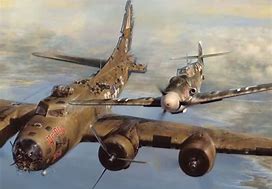A dreadfully damaged U.S. bomber, a B-17 named “Ye Olde Pub,” was still over German territory after its bomb run, needing to penetrate deadly Flak coastal airspace before reaching the North Sea. From below climbed a Luftwaffe ME-105 fighter of Fighter Wing 11, piloted by Lt. Franz Stigler. Stigler needed one more air victory to qualify for the coveted Knight’s Cross. The mutilated B-17 would be easy pickings.

The B-17’s guns were frozen and could not fire when Stigler’s 105 slid in beside the wounded Flying Fortress. Stigler couldn’t believe his eyes. What was keeping that airplane in the air, he wondered. Flying on only three engines, half its tail shot off and the plexiglass nose was missing. Through large holes in the bomber’s aluminum skin, Stigler could see men bent over wounded crewmembers. He witnessed the co-pilot slumped over the controls and the pilot, covered in blood, wrestling to keep the aircraft airborne.
Realizing, the Fortress was heading toward the murderous Flak coastal defenses, Stigler made a decision that could result in his court martial or even death by firing squad. Knowing the German artillery would not fire on one of its own aircraft, he decided that his recognizable German airplane would fly ahead of the B-17 and lead it through the defense zones.
Once safely over the North Sea, fearing the struggling aircraft would plunge into the sea at any moment, Stigler signaled the wounded pilot to turn 90 degrees and head for the much closer neutral country of Sweden. There, the crew would be incarcerated for the remainder of the war but would be well cared for. Lt. Brown, understanding the German pilot’s compassionate signals, refused and doggedly maintained his heading, continuing toward safety in England.
Magazine editor Adam Makos learned of this World War Two nobility between enemies forty-five years later in 1990. He was able to find Charlie Brown and asked for an opportunity to interview him for his magazine. Brown said, “I’ll talk to you but only after you visit with the Luftwaffe pilot, Franz Stigler.” Makos tracked down Stigler and after what turned into many conversations and correspondence wrote an incredible book about Stigler’s wartime experiences titled “A Higher Call.”
The nobility, chivalry, and valor of the German Air Force fighter pilots, unlike members of the Nazi party, gives one a look at America’s enemies in a totally different light. Fighter pilots of Fighter Wing 11 hated Hitler, Goering and the murderous Gestapo and SS forces and actually plotted a mutiny, however unsuccessfully.
You find yourself sympathetic as the war nears an end as Stigler and his few surviving pilots match wits in the skies against an overwhelming American Army Air Force while flying Germany’s last-ditch effort with the unreliable jet powered ME-262.
The eventual reunion of Charlie Brown, his surviving B-17 crew members, and pilot Franz Stigler is a scene beyond description. I wholeheartedly recommend reading this New York Times best seller “A Higher Call” by Adam Makos.